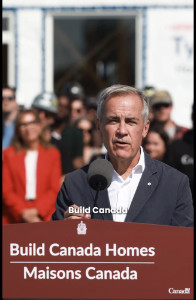[Ed’s Note: Dr. Rey Pagtakhan, a retired medical professor and lung specialist from the University of Manitoba and Winnipeg Children’s Hospital (1971-1988) and a former Member of Parliament (1988-2004) and cabinet minister – a historic first for a Canadian Filipino – is widely published in medical journals and textbook chapters and in community newspapers. This Commentary is from his column, Medisina at Politika, published in Winnipeg-based Pilipino Express.]
October 1, 2025 — Prime Minister Mark Carney launched Build Canada Homes (BCH)– a $13-billion initiative – on September 14th to rapidly increase the supply of homes, decrease the costs of building, tackle homelessness, make home affordable, and create a new Canadian housing industry.
Says the Prime Minister:
“Canada’s new government is relentlessly focused on bringing down housing costs. Central to that mission is rapidly scaling up the supply of homes. Build Canada Homes will create an entirely new housing industry using Canadian technology, Canadian workers, and Canadian resources and give builders the tools they need to build more, build sustainably, and build at scale.”
BCH adds to the new industrial strategy and the five nation-building projects launched earlier.
With BCH, Canada can confidently tackle its housing crisis and meet the projected 3.2 million homes needed in the coming decade.
Pillars of strength
Three words – build, finance, catalyze – describe BCH’s three pillars of strength.
- First, build affordable homes, that is, “lead the planning, management, and construction of affordable housing across the country.”
To realize, BCH will partner with industry, other levels of government, and Indigenous communities to build at scale and at speed; serve as the government’s new centralized agency for affordable housing; make it easier for builders to access the resources needed to build faster; offer financial incentives for large projects; and leverage public lands for housing. To streamline the latter, Canada Lands Company will be transferred to BCH and cabinet ministers are mandated to identify their department’s land holdings suitable for housing construction.
- Second, finance affordable homes, that is, “provide predictable, low-cost financing to support non-market and Indigenous housing providers to grow affordable and community housing.”
To achieve, BCH will deploy capital and use cost-efficient methods of construction such as factory-built, modular, and mass timber and mainstream these advanced construction methods to cut building timelines, reduce costs and lower emissions during construction.”
3. Third, catalyze the housing industry, that is, “help generate demand for innovative and sustainable building methods like factory-built and prefabricated construction.”
To make it happen, BCH will adopt the government’s new Buy Canadian policy and prioritize projects that use Canadian lumber and other Canadian materials. It will channel demand through Canadian industries from lumber and steel to aluminum and mass timber; strengthen domestic supply chains; scale up a home-grown housing industry; and create high-paying careers nationwide.
Mandate
BCH is determined to build at scale and at speed and preserve already existing affordable rental units. To implement this mandate, the Prime Minister has announced the following investments and initiatives:
- Six sites – Dartmouth, Longueuil, Ottawa, Toronto, Winnipeg, and Edmonton – have been prioritized for 4,000 factory-built homes on federal land – with additional capacity of up to 45,000 units – for mixed-income communities;
- $1 billion has been earmarked for transitional and supportive housing for people who are homeless or at risk of homelessness;
- Over 700 public, affordable, and supportive housing units will be built, in partnership with Nunavut Housing Corporation, with factory-built construction methods; and
- $1.5 billion Canada Rental Protection Fund will be launched to help protect existing affordable rental housing.
Says the Hon. Gregor Robertson, federal Minister of Housing and Infrastructure: “It’s not just about building more – it’s about building better and building bolder... so that everyone has a place to call home.”
Executive Leadership
Ms. Ana Bailão has been appointed Chief Executive Officer of BCH. She brings to the post extensive experience in advancing affordable housing, having served for over a decade on Toronto City Council including as Chair of its Planning and Housing Committee.” She led the creation of Housing Now, which uses city lands to build housing.
Says Ms. Bailão: “We are bringing together government, industry, and communities to build homes faster, smarter, and more sustainably. We’re not just building units – we’re building opportunity, dignity, and a future where everyone in Canada has access to the homes they need – and deserve.”
What BCH means for Canadians and Canada’s economy
 In terms of availability and affordability of homes, Canadians can expect “lower rents, lower new home prices, faster delivery, broader range of housing options for low- and middle-income Canadians (workers, families, students, and seniors), expanded access to transitional and supportive housing for those facing homelessness, and housing supply that better reflects the diverse needs of Canadians.”
In terms of availability and affordability of homes, Canadians can expect “lower rents, lower new home prices, faster delivery, broader range of housing options for low- and middle-income Canadians (workers, families, students, and seniors), expanded access to transitional and supportive housing for those facing homelessness, and housing supply that better reflects the diverse needs of Canadians.”
In terms of benefits from catalyzing and invigorating the housing industry, Canadians can expect “faster, more affordable housing built with Canadian innovation; more jobs in manufacturing, construction, and skilled trades; more resilient housing sector that meets future demand; and lower emissions through the use of sustainable building methods and low-carbon materials.”
From an invigorated new housing industry created from intensive building and diligent financing of affordable housing, the Canadian economy can anticipate “new jobs in construction, planning, and skilled trades; stronger regional economies through local procurement and partnerships; increased demand for Canadian materials like softwood lumber and Canadian technologies like factory-built housing; long-term investment in housing; growth in the non-market housing sector with reduced reliance on subsidies; and economic stimulus through construction, financing, and community development.”
From a catalyzed new industry created from high demand for innovative building methods like factory-built and prefabricated construction, the Canadian economy can anticipate “a revitalized homebuilding industry powered by Canadian expertise; increased demand for Canadian materials and technologies; long-term growth in advanced manufacturing; and strengthened domestic supply chains, supporting other Canadian industries.”
Summary
Build Canada Homes envisions a new chapter in Canadian housing industry that will both build at scale and at speed and preserve already existing affordable rental units. Keys to success are fourfold: 1) partnerships with other levels of government, the Indigenous communities, and private developers; 2) use of federally-owned lands, Canadian materials and labor; 3) transfer of ministerial responsibility for Canada Lands Company Ltd. to the Minister of Housing and Infrastructure to leverage the Company’s existing land holdings and development expertise; and 4) commitment to transform to an invigorated new Canadian home industry.
Build Canada Homes addresses meaningfully both the acute housing needs of the Canadian citizenry and the national aspiration of the Canadian economy for global leadership in modern homebuilding.













